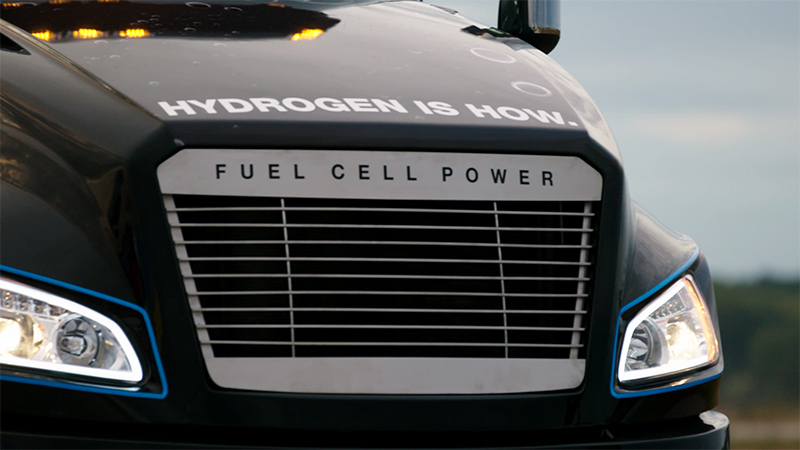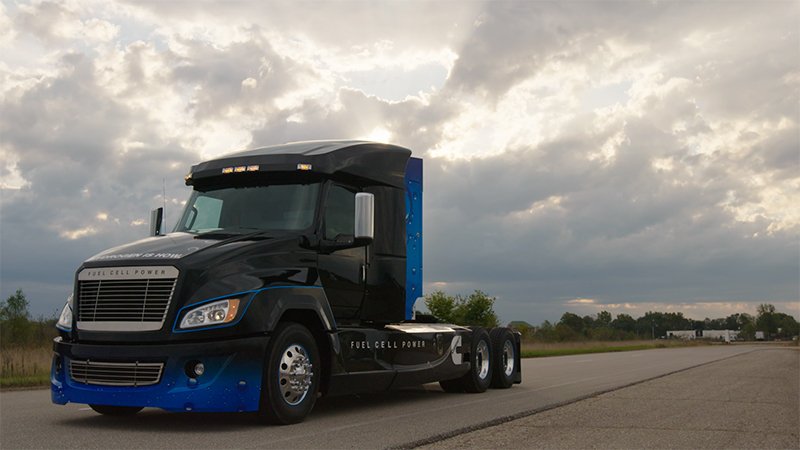Making a splash at NACV
By Cummins Inc., Global Power Technology Leader

Drip. Drip. Drip. It may just be tiny droplets of water dribbling out of Cummins’ latest innovation, but it is making a big splash this week at the North American Commercial Vehicle Show (NACV) in Atlanta. Building upon a long history of innovation and delivering industry-leading solutions, Cummins is displaying the newest development in the powertrain of choice: hydrogen fuel cell power.
Unveiling in a Big Way
After many months of behind the scenes work, which is really the culmination of more than 20 years of research and development around fuel cell technologies, Cummins has unveiled a heavy-duty truck with fuel cell and battery electric power. The zero-emissions class 8, 6x4 day cab tractor is a technology demonstrator suitable for vocational applications, including regional haul, urban delivery operations, port drayage and terminal container handling.
Under the Hood
The truck was designed and integrated by Cummins in Columbus, Ind. and includes a proton exchange membrane (PEM) fuel cell from Hydrogenics, a recent addition to the Cummins family. The truck was designed for 90 kW fuel cell and is scalable in 30 kW or 45 kW increments up to 180 kW and has 100 kWh lithium-ion battery capacity. The truck has a range of 150-250 miles between filling up, but that range can be extended with additional hydrogen tanks, increasing the tank storage pressure or installing additional fuel cells to optimize management of the vehicle load factor.

Many of the critical components of the powertrain, including the PEM fuel cell, system controller, powertrain controls, wire harnesses and junction boxes, among others, were designed and developed by Cummins. Cummins has also integrated third party components into the system.
The Look
Some might be surprised by the overall look of the fuel cell truck – it doesn’t feature any Cummins red! Instead, the exterior truck branding prominently showcases water. The meaning behind this is twofold. First, when the fuel cell is running, the exhaust consists of air and water. Liquid water flows out from an outlet hose behind the side panels on the driver’s side. Second, hydrogen can be sourced from water using a process called electrolysis to produce electrical energy. The use of water, along with the Jeopardy-style answer of “Hydrogen is how.” to the question of “How does it work?” helps to distinguish the hydrogen fuel cell technology that is unique to the vehicle.
The second thing you’ll notice about the truck is the OEM, or more accurately the lack thereof. The truck was not a collaboration with an OEM partner and was deliberately designed to be OEM agnostic. The goal was to allow all OEMs customers and end users to envision how Cummins fuel cell power can enable their success.
Without looking under the hood, the truck might look like any other truck, and in fact, the goal is to provide the same dependable performance as every other Cummins-powered truck. So, even though we never intend to manufacture the truck itself instead focusing on innovating the powertrain, having an OEM-neutral vehicle that showcases the art of the possible through a modern, innovative “package” is important to the overall positioning of the technology.
The Team Behind the Innovation
To say this was a team effort would be an understatement. The truck was designed and built at the Cummins Machine Integration Center (CMIC) in Columbus. The facility supports global vehicle integration efforts for multiple business segments for on- and off-highway equipment and features a dedicated EV Lab for electrification work. More than 30 engineers and technicians, including a few from Hydrogenics who jumped in post-acquisition, and numerous suppliers had a hand in taking this from simply a concept, to a truck that could be driven onto the tradeshow floor.
The truck is a example of the collaboration between system engineering, technology leadership teams within Electrified Power and Cummins research and technology group and the technical operations team at CMIC which supports Cummins Southern Indiana fleet of 450 vehicles.

Looking to the Next 100 Years
Cummins’ strategy is to provide our customers with a range of power options, from advanced diesel and natural gas internal combustion engines to battery electric and hydrogen fuel cell solutions. In the long-run, the customers we serve will likely need more than one type of power, depending on their specific markets, applications and use cases.
To this end, Cummins has made several recent announcements around fuel cells like the acquisition of Hydrogenics, a memo of understanding with Hyundai Motor Company to collaborate on hydrogen fuel cell technology across commercial markets in North America and an investment in Loop Energy, a fuel cell electric range extender provider. Developing the hydrogen fuel cell truck as technology demonstrator is a critical step in gaining valuable insights that are critical to continue developing the right solutions for the market and preparing for next 100 years.
So, the next time you hear a drip or step in a puddle, take a minute to think about the possibilities.
Author Profiles

Cummins Inc., Global Power Technology Leader
Cummins Inc., a global power leader, is committed to powering a more prosperous world. Since 1919, we have delivered innovative solutions that move people, goods and economies forward. Our five business segments—Engine, Components, Distribution, Power Systems and Accelera™ by Cummins—offer a broad portfolio, including advanced diesel, alternative fuel, electric and hybrid powertrains; integrated power generation systems; critical components such as aftertreatment, turbochargers, fuel systems, controls, transmissions, axles and brakes; and zero-emissions technologies like battery and electric powertrain systems and electrolyzers. With a global footprint, deep technical expertise and an extensive service network, we deliver dependable, cutting-edge solutions tailored to our customers’ needs, supporting them through the energy transition with our Destination Zero strategy. We create value for customers, investors and employees and strengthen communities through our corporate responsibility global priorities: education, equity and environment. Headquartered in Columbus, Indiana, Cummins employs approximately 70,000 people worldwide and earned $3.9 billion on $34.1 billion in sales in 2024.
Related Tags